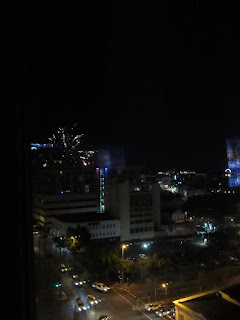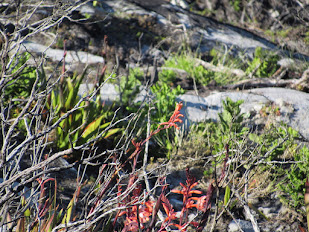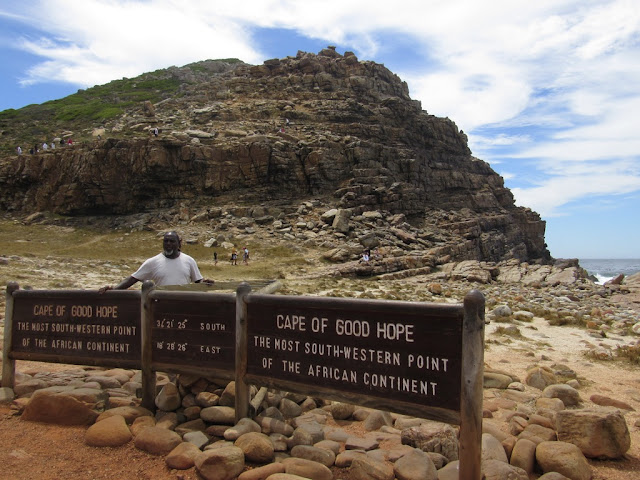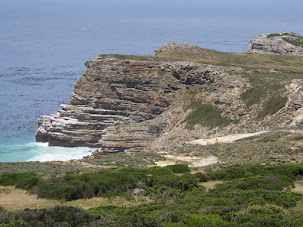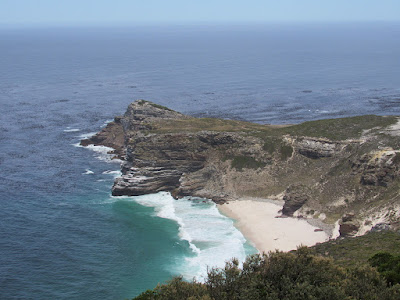The "Five Amigas" (plus one photographer) pose for a postcard portrait with the iconic Table Mountain.
On this five-day post-trip of the safari, we went on top of the mountain, visited African penguins, toured the seaside, and gazed at the rocky Cape of Good Hope located at the bottom of the world. On our last day in the city, half the group checked out the famous Stellenbosch Wine Country vineyards and the other half went to Robben Island, the 18-year prison home of Nelson Mandela. But first, we celebrated New Year's Eve.
New Year's Eve in Cape Town
New Year's Eve is a big celebration in Cape Town and it brings local people and many other South African tourists to town. Movement on the streets drew to a slow crawl due to over-crowded traffic and streets blocked streets for the parades on January 1 and 2. Getting around town was a challenge, but we were able to accomplish everything on our schedule thanks to Stanton, our cunningly strategic guide. He not only knew how to avoid downtown traffic, he knew how to get around other guide' tours around the Cape area--by going in the opposite direction.
Stanton picked us up at the airport and took us to our downtown hotel. After settling in briefly, Stanton gave us an hour-long walking tour around the neighborhood. The hotel was on the White side of the old apartheid dividing line, which faced the Black side that also used to house slaves before abolition. An apartheid leftover were these colorful houses. Table Mountain is in the background.
The Netherlands Consulate General is located across the street from our hotel.
The Dutch presence goes back to 1652 when Cape Town was founded by the Dutch East India Company to be a refreshment outpost that supplied ships with fresh water, fruits, vegetables, meat, and a rest for weary sailors. The indigenous Khoikhoi who grazed their cattle at the Cape were gradually eased out of their lands as the Dutch built their new city.
We passed by St. George's Cathedral where Bishop Desmond Tutu presided 1986-96.
Known as the “People’s Cathedral” for its role in the resistance against apartheid, St. George’s Cathedral is the oldest cathedral in southern Africa and the mother church of the Anglican Diocese of Cape Town, according to its website. It serves people of diverse backgrounds, both within and outside the congregation, who look to the Cathedral for leadership, spiritual guidance, and sustenance.
Before his appointment to St. George, Tutu was bishop of Johannesburg 1985-86. He also served as chairman of the Truth and Reconciliation Commission during the post-apartheid era. The theologian who was known for his work as an anti-apartheid and human rights activist also sought to fuse ideas from black theology with African theology.
In the evening Stanton called an Uber car to take us to Pigalle, a fancy French-style restaurant that served steak so tender it could be cut with a fork. A jazz band entertained the dinner guests and some people danced on the wooden floor next to the bandstand. Women were largely dressed up while most of the men wore casual clothes. Couples and groups of couples filled the dinner tables to celebrate the New Year. The place reminded me of 1920s night clubs that I had seen in the movies. Servers were well-trained, attentive, and well-dressed in black tuxedo-style bow ties, vests, and trousers with starched white shirts.
Stanton was just going to drop us off at the restaurant, but when he saw we were a little leery about getting back to the hotel on our own in a strange town, he remained with us for dinner. After he dropped us off, he went back to his family to celebrate the New Year. He was very kind to do that and we appreciated his gesture!
The streets were crowded with carloads of people going to family celebrations, bars, restaurants, the V&A Waterfront, or maybe just cruising. At midnight, the fireworks went off to bring in the New Year as well as shouts of joy from people in cars and those walking on the sidewalks. Below are some of the fireworks from my hotel room. This was truly a unique and memorable experience because we were celebrating the New Year in Cape Town!!!
I have been to many different places in the world on both Christmas and New Year's but this one in Cape Town was the most dynamic.

The CBD -- Central Business District at night is generally well lit. It is also one of the safest areas in the city with 24/7 security guards posted in little green-and-black booths. If you need help or directions, these booths were the place to go. There was one posted in front of our hotel.
Minstrel Parade -- January 2
Every year on January 2, the Minstrel Parade is held. It is reminiscent of Cape Town's past when slaves were allowed this day off for fun and family time. This tradition continues with the Tweede Nuwe Jaar Parade where thousands of people in glittery uniforms, face paint, hats and parasols march through the city’s streets, playing their signature “ghoema” music on banjos, trumpets, and drums, according to Cape Town Travel. And, it's so popular, people stake out their places on the curb the night before. At this time, choral groups also kick off a five-week series of competitions.
JP Smith, a member of the City of Cape Town’s mayoral committee for safety
and security, said the Tweede Nuwe Jaar Parade is an event with huge
historical and cultural significance to the people of Cape Town. “It
represents the rich heritage of our beautiful city and means so much to
thousands of Capetonians who have grown up with the culture associated
with the minstrels and the Tweede Nuwe Jaar Parade," according to The Plainsman. "The City of Cape Town’s annual support for the event is to ensure
that we can contribute to preserving this history and culture for the
next generation."
Our group was busy touring Table Mountain and Cape Point so we didn't see much of the parade. Besides, the streets were so crowded, it was impossible to see anything anyway. However, with the help of Google Images and The Plainsman, here are some shots and explanations of the event to give an idea of the day's extravaganza that is akin to Carnival in Rio de Janeiro or New Orleans.
80,000 people attended the parades, according to The Plainsman newspaper.
Table Mountain

A cableway invented, manufactured, and installed by the Dutch takes thousands of people up and down Table Mountain. Stanton was able to avoid the crowds of tourists and local people who use New Year's Day to visit the mountain. An early breakfast helped.
Once the cableway took us up the mountain, we followed the marked path around the top and took in several breath-taking views of the land and sea below.



Not long ago, a fire ripped through Table Mountain and left these charred rocks.

However, these beautiful fire lilies were the first plants to sprout after the
fire. This is a lesson of the Hindu god, Kali: what she destroys, she
recreates.

Eve's Footprint
 As you look across the bay
and up the West Coast, it was there that 117,000 years ago one of our
early modern ancestors may have stared back at you as she stood in the
wet sand of the Langebaan Lagoon. Archaeologists who identified her
fossilized footprints called her "Eve".
As you look across the bay
and up the West Coast, it was there that 117,000 years ago one of our
early modern ancestors may have stared back at you as she stood in the
wet sand of the Langebaan Lagoon. Archaeologists who identified her
fossilized footprints called her "Eve".
She is not, however, our earliest ancestor. Indeed, Stone Age artifacts found around the foothills of this mountain suggest that our more ancient relatives lived here as early as a million years ago. (Table Mountain National Park)
Khoi herders arrived here in the Western Cape about 2,000 years ago. They found grazing land and sources of fresh water on the slopes and foothills of Table Mountain, particularly during the dry summer months. Having brought their sheep and cattle here for generations, it was these people who met the first Europeans to set foot upon these shores.
The paths at Eve's Footprint overlook
Stefani and Helena at Eve's Footprint with the Cape Town bay.
Lion's Head lies between Table Mountain and Signal Hill and stands at 2,195 feet above sea level. Robben Island is at the top of the photo. The stadium is to the right of Signal Hill near the coastline. (photo by Wikipedia)
The 17th century Dutch called the peak Lion's Head and Signal Hill as Lion's Tail since the shape of these two land forms resembles a crouching lion.
Lion's Head served as a sacred place for the Cape Malay community in an area called Bo-Kaap. The residents there are descendants of the slaves brought by Dutch settlers from Malaysia, Indonesia, and Africa who used the lower slopes and Signal Hill for graves and shrines.
In 1897 gold was discovered on Lion's Head, but the grade
was too low to be profitable so the mine closed after a year. Although
the suburbs
of the city surround Lion's Head and Signal Hill, city authorities
have successfully restricted housing developments on them.
Robben Island served first as a leper colony and later as a prison colony. Nelson Mandela spent 18 years of his life there. Today, the prison is a museum with tours led by former prisoners.
The oil tankers park themselves here because it is cheaper than docking in the harbor.
The Cape Town Stadium known as the DHL Stadium is an association soccer and rugby stadium that was built for the 2010 FIFA World Cup. It is the home of WP Rugby and the DHL Stormers since 2021 and host for other Cape Town teams as well.
The stadium had a seating capacity of 64,100 during the 2010 World Cup, but was later reduced to 58,309. Its construction began in March 2007 and was completed in 33 months at a cost of approximately US$600 million.
The Cape of Good Hope
I always loved studying maps. It's how I learned my geography. However, seeing the Cape of Good Hope on the southern tip of Africa became both a wonder about its odd name and an inviting dream destination. So here I was at the bottom of the world--or at least the African bottom--at a place that changed the world in the 15th century as Europeans sought trade routes to India.
Although the Cape of Good Hope is on the southern tip of Africa, it is neither the dividing point between the Atlantic and Indian Oceans nor the southernmost point of Africa. That distinction belongs to Cape Agulhas about 90 miles to the southeast. Park officials put up this sign anyway, which gives tourists a lot of pleasure snapping photos of themselves.
(I thought I had my photo taken on this spot, but apparently not. ARGH! At least I took a photo of this man with the sign as a long line of visitors waited their turn to do the same thing.)
The picturesque rocky shores of the Cape of Good Hope are beautiful, but the hazards they posed to 15th century sailors were monumental. This area of the sea marks the point where currents take a ship eastward than southward. Rounding the cape required a southward route in the open ocean and quite a bit west of the African coast. The first European to discover this route was the Portuguese explorer Bartolomeu Dias on March 12, 1488. He named the area the "Cape of Storms" to describe the challenges it presented to his accomplishment. King John II of Portugal (1477, 1481-99) later renamed this place the "Cape of Good Hope" because of the great optimism it engendered thanks to the discovery of a long-sought sea route to India and the East.
Bartolomeu Dias (c. 1450 – May 29, 1500) was the first European to go around the Cape on March 12, 1488. He was a Portuguese explorer.
Vasco da Gama, (c. 1460s – December 24, 1524), First Count of Vidigueira and a Portuguese explorer, was the first European to reach India by sea on May 20, 1498.
After rounding the Cape of Good Hope, da Gama followed the eastern coast of Africa northward before sailing due east to India.
The Portuguese government commemorated the accomplishments of Bartolomeu Dias and Vasco da Gama with crosses at the Cape of Good Hope.
Stanton, our Cape Town guide Meagan on the rocks near shore
Big rocks with patterned gutters, cracks and crevices like these were created by the tides, rain water, and erosion.

The beauty of the sea, mountains, and rocks at the Cape is unfathomable. We spent a lot of time just looking at it and taking it all in.
Cape of Good Hope Nature Reserve

The Cape of Good Hope looking west, from the coastal cliffs above Cape Point, overlooking Dias beach. This is the other side of the Cape of Good Hope marker that provides some stunning views of the sea, mountains, and rocky shores.

The vast blue ocean was mesmerizing. The mountains that touched the sea projected the transformational strength of Nature and its geological forces at work. We are indeed small in this world as natural places of greatness and beauty remind us.
Noordhoek Farm Village

African Penguins -- an endangered species
One of the highlights of our Cape Point tour were the African penguins at Boulders. These little guys that stand about 24-28 inches tall and weigh 5-7.7 pounds were fun to watch as they played, flirted, and nested. However, like some glaciers that are melting before our very eyes, the penguins will soon die out at the present rate of their decline in population.
Boulders is one of the African penguins' few breeding areas between Namibia and the southern coast of Africa. Tragically, a 95% decline in population since 1800 threatens their extinction by 2026. We may have seen the last generation of this species.
1800 -- 4 million
1910 -- 1.5 million
1995 -- 150,000
2000 -- 150,000 - 180,000
2010 -- 55,000
Today, their breeding areas are largely restricted to 24 islands near Namibia to the Boulders Beach and Algoa Bay, about nine hours east of Cape Town along the coast.

African penguins spend most of their lives at sea until its time for them to mate and lay their eggs. Here are couples getting ready to nest (above left) and already nesting (above right). We were fortunate enough to be there for this event.

The mother and father take turns sitting on the nest for about 40 days before the chicks are born. Here are baby chicks both in and out of the nest. They will spend 60-130 days hanging out before they go into the sea on their own for the next one to two years. Afterward, they return to their natal colony and molt into adult plumage.

When penguins molt, they are unable to forage in the sea since their new feathers are not yet waterproof. That means they don't eat for three weeks, and they lose about half of their body weight.
Love Story


The African penguin is monogamous and penguin mating is a romantic love story. They breed in colonies and pairs return to the same site each year. Females remain fertile for about 10 years.
Penguins like to hang together on these shoreline rocks of their breeding grounds.
Our time in Cape Town was short, but we saw its major highlights, we experienced an festive holiday, we spent time in an important historical site not only for 15th century explorers but for 20th century advocates who ended the unjust system of apartheid. (See my blog on Robben Island as well as Johannesburg.) As with all my travels, learning about other countries, their history, their cultures, their struggles is the most valuable thing I do--and I have been fortunate in being able to see the world and share it with others.
Sources
https://sahistory.org.za/article/dutch-settlement
https://en.wikipedia.org/wiki/Vasco_da_Gama
https://en.wikipedia.org/wiki/Cape_of_Good_Hope
https://en.wikipedia.org/wiki/African_penguin
https://en.wikipedia.org/wiki/Cape_Town_Stadium
https://en.wikipedia.org/wiki/Lion's_Head_(Cape_Town)






